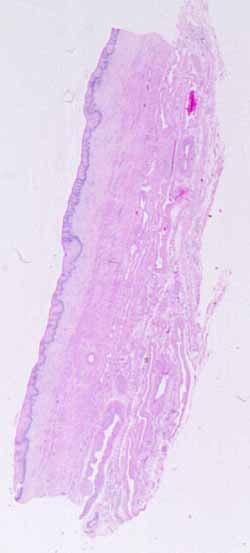
This specimen is moderately difficult, partly because it superficially resembles a completely different organ, and partly because the actual source may be overlooked when considering hypotheses.Note the various layers of the specimen.
- Are the layers similar along the entire length of the specimen?
- How distinct are the layers?
- Which organs have distinct layers, and which have layers which are not so distinct?
Note specific features of the mucosal layer.
- Make sure you examine the entire epithelial surface.
- What shape is the surface?
- How many different types of epithelium can you find?
- What kind(s) of cells comprise each type of surface epithelium?
- Are there any epithelial features (e.g., glands or crypts) embedded in the lamina propria?
- Can you see a distinct muscularis mucosae? If so, does it extend along the entire length of the specimen?
Are there any distinctive features in the submucosal tissues? Pay special attention to blood vessels, nerves, and smooth muscle.
Hints on the next page are rather more revealing. Do not proceed until you have carefully examined all the notes above.
